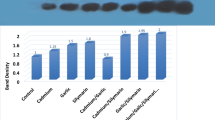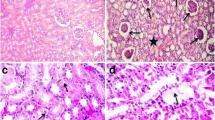Abstract
Recent studies have described lipid peroxidation to be an early and sensitive consequence of cadmium exposure, and free radical scavengers and antioxidants have been reported to attenuate cadmium-induced toxicity. These observations suggest that cadmium produces reactive oxygen species that may mediate many of the untoward effects of cadmium. Therefore, the effects of cadmium (II) chloride on reactive oxygen species production were examined following a single oral exposure (0.50 LD50) by assessing hepatic mitochondrial and microsomal lipid peroxidation, glutathione content in the liver, excretion of urinary lipid metabolites, and the incidence of hepatic nuclear DNA damage. Increases in lipid peroxidation of 4.0- and 4.2-fold occurred in hepatic mitochondria and microsomes, respectively, 48 h after the oral administration of 44 mg cadmium (II) chloride/kg, while a 65% decrease in glutathione content was observed in the liver. The urinary excretion of malondialdehyde (MDA), formaldehyde (FA), acetaldehyde (ACT), and acetone (ACON) were determined at 0–96 h after Cd administration. Between 48 and 72 h posttreatment maximal excretion of the four urinary lipid metabolites was observed with increases of 2.2- to 3.6-fold in cadmium (II) chloride-treated rats. Increases in DNA single-strand breaks of 1.7-fold were observed 48 h after administration of cadmium. These results support the hypothesis that cadmium induces production of reactive oxygen species, which may contribute to the tissue-damaging effects of this metal ion.
Similar content being viewed by others
References
D. Manca, A. C. Ricard, B. Trottier, and G. Chevalier, Studies on lipid peroxidation in rat tissues following administration of low and moderate doses of cadmium chloride,Toxicology 67, 303–323 (1991).
L. Muller, Consequences of cadmium toxicity in rat hepatocytes: Mitochondrial dysfunction and lipid peroxidation,Toxicology 40, 285–292 (1986).
M. W. Fariss, Cadmium toxicity: Unique cytoprotective properties of alpha tocopheryl succinate in hepatocytes,Toxicology 69, 63–77 (1991).
T. Hussain, G. S. Shukla, and S. F. Chandra, Effects of cadmium on superoxide dismutase and lipid peroxidation in liver and kidney of growing rats: In vivo and in vitro studies,Pharmacol. Toxicol. 60, 355–358 (1987).
T. Koizumi and Z. G. Li, Role of oxidative stress in single-dose, cadmium-induced testicular cancer,J. Toxicol. Environ. Hlth 37, 25–36 (1992).
A. Hudecova and E. Ginter, The influence of ascorbic acid on lipid peroxidation in guinea pigs intoxicated with cadmium,Fd. Chem. Toxic. 30, 1011–1013 (1992).
C. Casals, M. Gasset, M. C. Mendez, P. Garcia-Barreno, and A. M. Munico, Lipid alterations in liver and kidney induced by normobaric hyperoxia: Correlations with changes in microsomal membrane fluidity.Biochem. Med. Met. Biol. 37, 269–281 (1987).
O. H. Lowry, N. J. Rosebrough, W. L. Farr, and R. J. Randall, Protein measurement with the folin phenol reagent,J. Biol. Chem. 193, 265–275 (1951).
J. A. Buege and S. D. Aust, Microsomal lipid peroxidation,Methods Enzymol. 51, 302–310 (1972).
C. Largilliere and S. B. Melancon, Free malondialdehyde determination in human plasma by high-performance liquid chromatography,Anal. Biochem. 170, 123–126 (1988).
M. Bagchi, E. A. Hassoun, D. Bagchi, and S. J. Stohs, Endrin-induced increases in hepatic lipid peroxidation, membrane microviscosity, and DNA damage in rats,Arch. Environ. Contam. Toxicol. 23, 1–5 (1992).
M. A. Shara, P. H. Dickson, D. Bagchi, and S. J. Stohs, Excretion of formaldehyde, malondialdehyde, acetaldehyde and acetone in the urine of rats in response to 2,7,8-tetrachlorodibenzo-p-dioxin, paraquat, endrin and carbon tetrachloride,J. Chromatogr. 576, 221–233 (1992).
S. J. Stohs and D. Bagchi, Oxidative mechanisms in the toxicity of metal ions,Free Rad. Biol. Med. 18, 321–336 (1995).
T. A. Chin and D. M. Templeton, Protective elevations of glutathione and metallothionein in cadmium exposed mesangial cells,Toxicology 77, 145–156 (1993).
W. Li, Y. Zhao, and I. N. Chou, Alterations in cytoskeletal protein sulfhydryls and cellular glutathione in cultured cells exposed to cadmium and nickel ions,Toxicology 77, 65–79 (1993).
D. W. Foster, Diabetes mellitus, inHarrison's Principles of Internal Medicine, E. Braunwald, K. J. Isselbacher, R. G. Petersdorf, J. D. Wilson, J. B. Martin, and A. S. Fauci, eds., McGraw-Hill, New York, pp. 1778–1796 (1987).
D. K. Winters, L. A. Clejan, and A. I. Cederbaum, Oxidation of glycerol to formaldehyde by rat liver microsomes,Biochem. Biophys. Res. Commun. 153, 612–617 (1988).
L. A. Clejan and A. I. Cederbaum, Stimulation of paraquat of microsomal and cytochrome P-450-dependent oxidation of glycerol to formaldehyde,Biochem. J. 295, 781–786 (1993).
S. N. Dhanakoti and H. H. Draper, Response of urinary malondialdehyde to factors that stimulate lipid peroxidation in vivo.Lipids 22, 643–646 (1987).
P. I. Akubue, D. Bagchi, W. J. Ihm, and S. J. Stohs, Excretion of malondialdehyde, formaldehyde, acetaldehyde, acetone and methyl ethyl ketone in the urine of rats given an acute dose of malondialdehyde,Arch. Toxicol. 68, 338–341 (1994).
Author information
Authors and Affiliations
Rights and permissions
About this article
Cite this article
Bagchi, D., Bagchi, M., Hassoun, E.A. et al. Cadmium-induced excretion of urinary lipid metabolites, DNA damage, glutathione depletion, and hepatic lipid peroxidation in sprague-dawley rats. Biol Trace Elem Res 52, 143–154 (1996). https://doi.org/10.1007/BF02789456
Received:
Accepted:
Issue Date:
DOI: https://doi.org/10.1007/BF02789456




